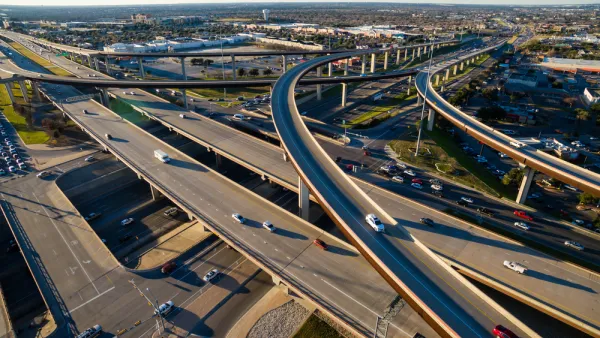If American politicans and bureaucrats had favored public transit or pedestrians as aggressively as they favored cars in the 20th century, public policy would be very different indeed.
After reading yet more blather about the "war on cars" or "density-pushing planners" I recently had a thought: what if government really did favor transit and compact development as aggressively as they had favored sprawl in the 20th century? How different would planning and transportation rules be?
For example, in the first half of the 20th century, government at all levels spent public money on roads for automobiles, while giving limited or no support to streetcars (which at first were private). As transit providers began to lose money, government took them over, and the federal government started to support public transit in the 1960s. Today, the federal government spends about four times as much on highways as on public transit. As a result of these policies, many cities have weak public transit systems, while many people and jobs have moved to suburbs served by highways.
So if government completely reversed course in the 21st century, it would reverse funding ratios: that is, spend half a century spending several times as much on public transit as on highways, and then spent another half century completely defunding highways (much as it ignored transit in the early and mid-20th century).
In the 1950s, government heavily subsidized suburbia, through Federal Housing Administration (FHA) lending criteria that favored suburbs. For example, FHA refused to subsidize mortgages in racially diverse urban neighborhoods, and favored new single-family homes (which tended to be in suburbs) over renovating existing homes- a policy that encouraged middle-class homeowners to move to suburbs. So to completely reverse course, the FHA would have to spend a couple of decades refusing to insure mortgages in any neighborhood built after the New Deal, while subsidizing mortgages in older neighborhoods.
These education and housing policies affected where we grow- that is, why people moved from cities to suburbs. But a somewhat different set of policies affect how we grow- that is, why suburban (and in some cities, urban) development is oriented almost exclusively towards cars.
Since the 1920s, most American zoning codes have mandated that huge swaths of land be limited to low-density residential use, ensuring that many Americans do not live within walking distance of public transit. To truly reverse this policy, government would have to spend the 21st century mandating that new development be at densities sufficient to support transit, and would require a mix of residential and commercial uses to the extent possible.
Since the 1950s, most zoning codes have also required that commercial landowners and multifamily dwellings provide visitors with parking lots and garages, thus effectively subsidizing driving by making parking more abundant. And because zoning codes also required buildings to be set back from the street, these parking lots were usually in front of buildings, thus ensuring that pedestrians must waste time walking through ugly parking lots in order to reach their destinations. To reverse this policy over the next 60 years, government would have to establish maximum parking requirements (as a few cities have in fact done) and require buildings to be in front of sidewalks so pedestrians could reach them more easily.
I do not favor all of the policies suggested above; some seem a bit too intrusive and paternalistic. However, these ideas are worth thinking about as an intellectual exercise - that is, to see how much change would have to occur for government to favor nondrivers as aggressively as it favored drivers in the 20th century.

Analysis: Cybertruck Fatality Rate Far Exceeds That of Ford Pinto
The Tesla Cybertruck was recalled seven times last year.

National Parks Layoffs Will Cause Communities to Lose Billions
Thousands of essential park workers were laid off this week, just before the busy spring break season.

Retro-silient?: America’s First “Eco-burb,” The Woodlands Turns 50
A master-planned community north of Houston offers lessons on green infrastructure and resilient design, but falls short of its founder’s lofty affordability and walkability goals.

Test News Post 1
This is a summary

Analysis: Cybertruck Fatality Rate Far Exceeds That of Ford Pinto
The Tesla Cybertruck was recalled seven times last year.

Test News Headline 46
Test for the image on the front page.
Urban Design for Planners 1: Software Tools
This six-course series explores essential urban design concepts using open source software and equips planners with the tools they need to participate fully in the urban design process.
Planning for Universal Design
Learn the tools for implementing Universal Design in planning regulations.
EMC Planning Group, Inc.
Planetizen
Planetizen
Mpact (formerly Rail~Volution)
Great Falls Development Authority, Inc.
HUDs Office of Policy Development and Research
NYU Wagner Graduate School of Public Service




























